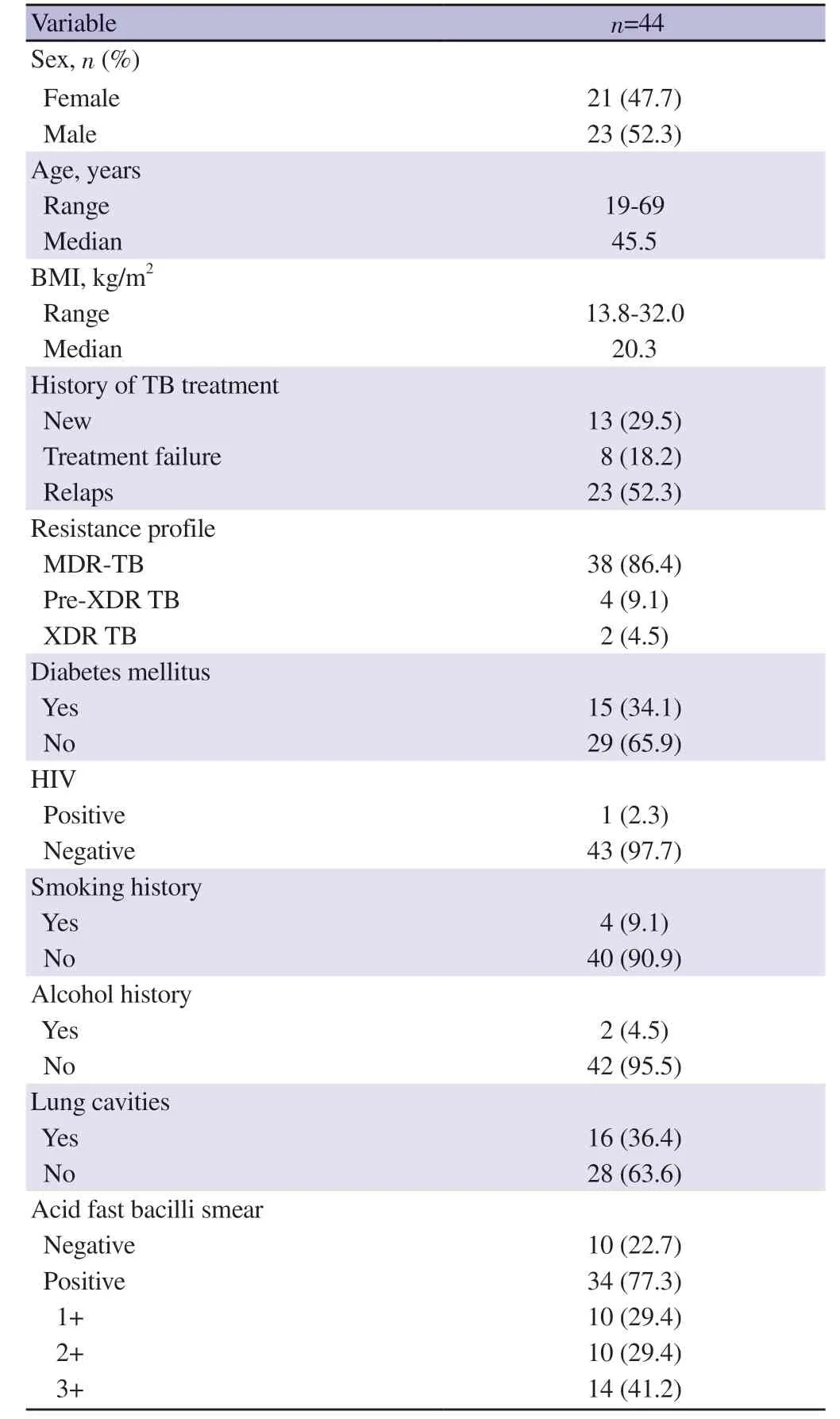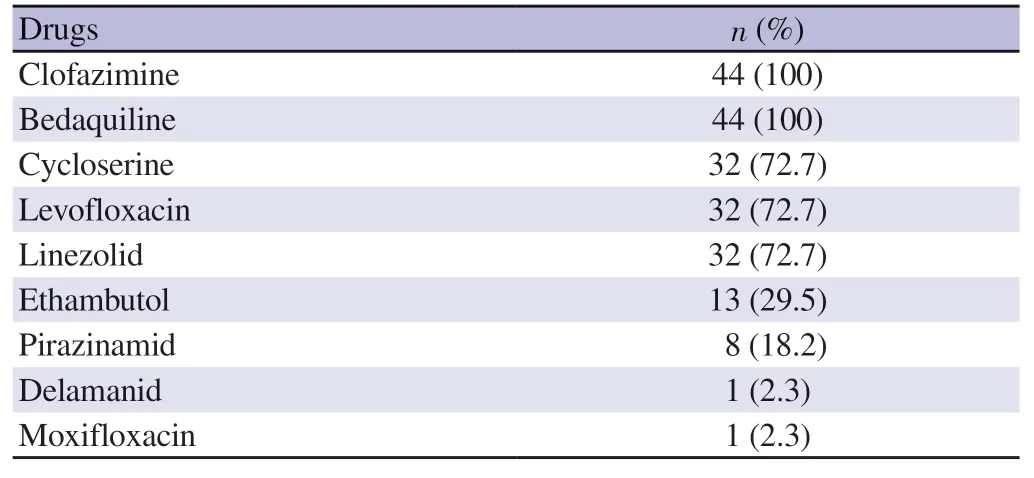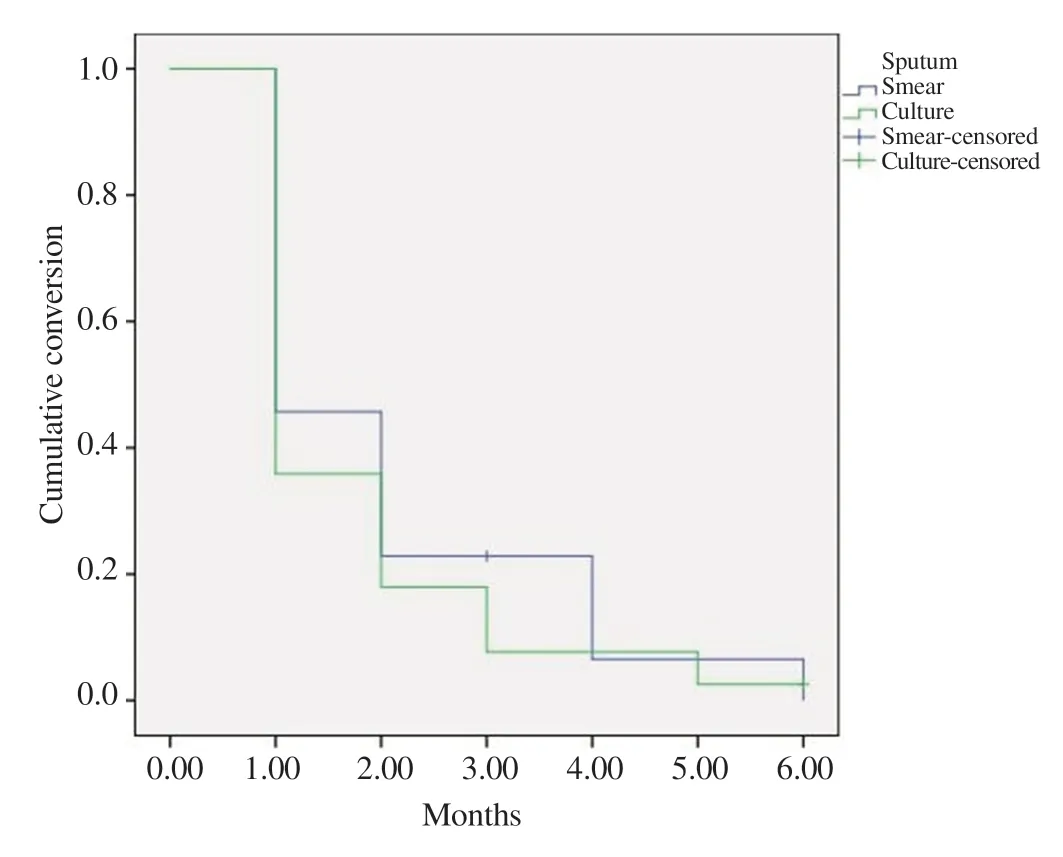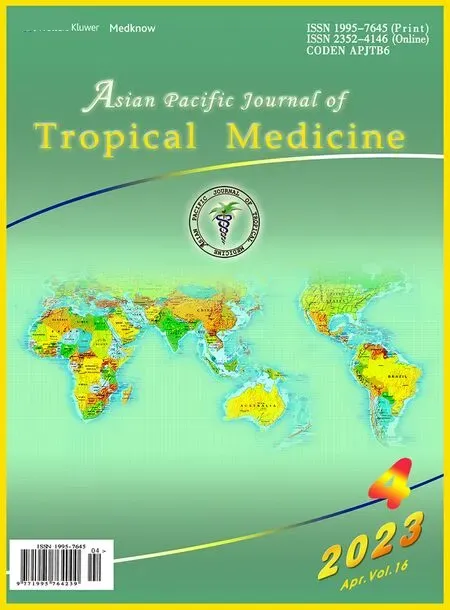Early efficacy of individual regimens containing bedaquiline in patients with drug resistant tuberculosis
Oki Nugraha Putra, Yulistiani Yulistiani, Soedarsono Soedarsono, Susi Subay
1Doctoral Program of Pharmacy, Faculty of Pharmacy, Airlangga University, Surabaya, Indonesia
2Program Study of Pharmacy, Faculty of Medicine, Hang Tuah University, Surabaya, Indonesia
3Faculty of Pharmacy, Airlangga University, Surabaya, Indonesia
4Faculty of Medicine, Hang Tuah University, Surabaya, Indonesia
5Department of Pulmonology and Respiratory Medicine, Dr.Soetomo Hospital, Surabaya, Indonesia
ABSTRACT Objective: To evaluate early efficacy of sputum conversion within 6 months of individual regimens containing bedaquiline in patients with drug resistant tuberculosis.Methods: We conducted a retrospective study among patients with drug resistant tuberculosis who were receiving individual regimens containing bedaquiline.The primary outcome was sputum conversion of both smear and culture within 6 months of treatment.We used medical records of drug resistant tuberculosis patients from January 2020 to December 2021.The study was conducted at Dr.Soetomo Hospital, Indonesia from August to October 2022.Results: In this study, 44 eligible drug resistant tuberculosis patients were initiated on regimens containing bedaquiline.There were 52.3% males and the median age was 45.5 years.The rates of previous treatment (70.5%) and lung cavity (36.4%) were high.The most common companion drugs included clofazimine, cycloserine,levofloxacin, and linezolid.Sputum smear and culture conversion was seen in 79.4% and 82.1% at the 2nd month, respectively.More than 97% patients had smear and culture conversion at the end of 6 months.Conclusions: Among drug resistant tuberculosis patients, individual regimens containing bedaquiline were associated with high rates of smear and culture conversion at the end of 6 months.Early efficacy of regimens containing bedaquiline can be used to predict cure rate at the end of treatment.
KEYWORDS: Bedaquiline; Individual regimen; Drug resistant tuberculosis; Efficacy
1.Introduction
Patients with drug resistant tuberculosis (DR TB) are difficult to treat and have poor long-term outcomes[1].According to the resistance profile, DR TB is divided into multi-drug resistant TB(MDR-TB), pre-extensively drug-resistant TB (pre-XDR TB), and extensively drug-resistant TB (XDR TB)[2].Numerous studies in Indonesia showed that the success rate in DR TB patients using
Significance
Although some studies in several countries have reported successful treatment in drug resistant tuberculosis patients, the results vary depending on the type of resistance, concomitant drugs, comorbidities, and lung cavity disease.This is a brief report in Indonesian drug resistant tuberculosis patients regarding the early efficacy of an individual regimen containing bedaquiline in drug resistant tuberculosis patients.This study shows that a regimen containing bedaquiline results in satisfactory sputum conversion at the end of sixth month.It can be used as early information to increase the uptake of bedaquiline into the programmatic regimen of drug resistant tuberculosis patients.second-line injection drugs was less than 50%[3,4].It indicates that the main problems in the management of DR TB patients are low success rate.Therefore, an adequate therapeutic strategy is needed to increase a success rate in DR TB patients.
According to the World Health Organization (WHO)recommendations, treatment for DR TB uses a regimen without injectable drugs and is divided into short-term and long-term or individual regimens[5].Patients who do not meet the criteria for shortterm therapy are given individual regimens.According to the study by Soedarsono et al, it reported that resistance to fluoroquinolone and second-line injectable drugs as well as incidence of QTc interval prolongation were some reasons to switch short-term into individual regimens[6].The requirements for the individual regimen are those with pre-XDR TB, XDR TB, failed short-term regimens, returned after treatment discontinuation, and relapsed.In contrast to the shortterm regimen, it can be modified according to the patient's condition to increase the effectiveness and safety within 18-24 months.The drugs given in individual regimens are tailored to the resistance pattern and the patient's clinical condition[5].
Indonesia is in the top ten countries with a high burden of TB, TB/HIV, and DR TB.The estimated DR TB cases in Indonesia are 2.4% of all new TB patients and 13% of those who have been treated, with a total estimated incidence of DR TB cases of 24 000 or 8.8/100.000 population[7].With support from government, The Indonesia National Tuberculosis Program implemented bedaquiline into programmatic use for the treatment of DR TB[8].Replacing secondline injectable drug-based regimens with bedaquiline-based therapies has proven to increase the effectiveness and safety of DR TB treatment[9-11].Furthermore, bedaquiline-based regimen appeared to be cost-effective for DR TB treatment compared to the secondline injectable drugs[12].Adding bedaquiline in DR TB treatment increases intracellular killing activity against Mycobacterium tuberculosis (MTB).It was supported by Giraud-Gatienau et al,reported in macrophages infected with MTB after administration of bedaquiline; there was an increase of autophagy activity,characterized by increased microtubule-associated protein light chain 3B and nitric oxide, decreased glycolysis, and macrophage lysosomal activity[13].
Sputum culture is still considered as a gold standard to assess treatment success, although it takes a long time, is costly, and requires standardized facilities[14].Sputum culture conversion is defined as sputum culture from positive to negative and is used as a standard interim outcome in DR TB treatment[15,16].Sputum culture conversion was significantly associated with treatment outcomes[17].The study by Javaid et al.reported that to estimate cure, the sensitivity and specificity of sputum culture conversion at six months were 97.6% and 44.4%, respectively.Furthermore, the association of sputum culture conversion with cure was significantly greater at sixth month (OR 32.10) than at four months (OR 14.13)[18].Another study by Meyvisch et al.showed that conversion of sputumcultures at 24 weeks provided greater prognostic value for clinical outcome than sputum culture conversion at 8 weeks when assessing the outcome of adding a new drug for the DR TB regimen[19].Using sputum culture conversion at month 6 as a proxy marker to predict final outcomes can reduce the physicians waiting period to decide about regimen efficacy.
Based on this background, the aim of this study was to describe early efficacy in Indonesian DR TB patients using individual regimens containing bedaquilline on sputum conversion within six months of treatment.Our overall goal was to provide valuable data on the programmatic use of regimens containing bedaquiline to help its appropriate and responsible use.
2.Subjects and methods
This was a single centre retrospective study at the Dr.Soetomo Hospital, in Surabaya, Indonesia.It is a referral hospital that provides treatment for DR TB patients.This study used medical records of DR TB patients who received individual regimens from January 2020 to December 2021.This study was conducted from August to October 2022.This study had received approval from the Health Research Ethics Committee of Dr.Soetomo Hospital with number 0448/KEPK/VII/2022.Since the study was a retrospective, informed consent was waived.
The inclusion criteria of this study were (a) DR TB patients aged 18 years old or above; (b) completed six months of treatment; (c)GeneXpert/MTB RIF assay showed rifampicin resistant, and (d)used individual regimens containing bedaquiline together with personalized background therapy.Individual regimens used in our hospital were combination from group A (levofloxacin, bedaquiline,linezolid) and group B (cycloserine, clofazimine), with or without group C (pirazinamid, delamanid, ethambutol, etc).The individual regimen consists all oral with at least five effective drugs.The selection of combined drugs was based on drug susceptibility testing,resistance pattern, adverse effects, and clinical condition.
Patients were followed up with minimum duration of six months(24 weeks).For individual regimens, bedaquiline was given at a dose of 400 mg for the first two weeks and then 200 mg thrice weekly for 22 weeks.All drugs were administered under observation.Patients took all drugs including bedaquiline in hospital for the first two weeks, followed by outpatient management.
Culture information and sputum smear during the 24 week and concomitant of the regimen administered at baseline were collected for each patient.The exclusion criteria were incomplete data of medical record including the examination of sputum smear or culture.Sputum samples were collected monthly for smear and culture as part of routine care until six months was done.We restricted patients in this study who had a positive baseline smear or sputum culture to be included in our analysis.Successful outcome was defined as culture conversion within six months in two consecutive, negative culture collected at least 15 days apart in Lowenstein-Jensen Medium.Smear sputum was conducted using Ziehl-Neelsen stain, and classified as negative, scanty, 1+, 2+, and 3+, according to bacterial load.Patients who had positive culture at sixth months were classified as not having converted.Baseline data including demographic information, baseline culture status and sputum smear, disease type, HIV, lung cavities, drug resistance category, comorbidities, and history of prior treatment were collected and recorded for further analysis.Categorical data were reported as numbers and proportions; meanwhile, continuous data were reported as median.Rate of sputum smear and sputum culture conversion was reported as percentage.We used Kaplan-Meier analysis to calculate the cumulative proportion of sputum conversion, including smear and culture during six months of therapy.
3.Results
We included 44 eligible DR TB patients on individual regimens containing bedaquiline from January 2020 to December 2021.The flowchart of the included patients was shown in Figure 1.

Figure 1.Flowchart of the study.
The demographic data was shown in Table 1.The median age and BMI at initiation was 45.5 years and 20.3 kg/m2, respectively.A total of 23 (52.3%) patients were men.Of the 44 patients, 9.1%(4/44) and 4.5% (2/44) had pre-XDR and XDR TB, respectively.All included patients were pulmonary TB.Based on the type of patients,31 (70.5%) were previously treated of TB.Of all 44 DR TB patients,22.7% were sputum smear negative, and the rest 29.4% had a 1+ and 2+, respectively, and 41.2% had a 3+ sputum smear grading results.Of the 44 patients, 34 (77.3%) and 39 (88.6%) had smear and culture positive, respectively.

Table 1.Demographic data of drug resistant tuberculosis patients.
Companion drugs at the initiation of treatment was shown in Table 2.All included patients received bedaquiline and clofazimine.Ethambutol, pirazinamid, and delamanid belonging to group C were administered less than 30%.

Table 2.Companion drugs at the initiation of individual regimen.
Of all the 44 patients initiated on treatment, 34 (77.3%) had a smear positive and 39 (88.6%) had a culture positive at baseline.Among the 44 patients, 42 (95.5%) and 43 (97.7%) had sputum smear and sputum culture conversion at the 6th month, respectively as shown in Table 3.Kaplan-Meier analysis of proportion of sputum positive between smear and culture during six months of therapy was shown in Figure 2.Mean time of sputum smear and culture conversion was 1.8 and 1.7 months, respectively.

Table 3.Smear and culture status of patients in six months of treatment.

Figure 2.Kaplan-Meier curve of the time of smear and culture conversion.
4.Discussion
To the best of our knowledge, this is a first report of DR TB patients in Indonesia who have been treated with individual regimens containing bedaquiline together with four effective antitubercular drugs according to WHO recommendation under programmatic conditions.Among the 44 patients, 31 (70.5%) had a history of TB treatment.According to the global surveillance data, prior exposure to antitubercular drugs in amounts inadequate for complete treatment is widely accepted as a trigger of drug resistance.Prior exposure to antituberculosis drugs may increase the likelihood of infecting strains developing multidrug resistance, especially if noncompliance is observed[20].The majority of MDR-TB cases are the result of poor adherence to TB medications, irregular drug use,disrupted drug supplies, physician error, and the availability of drugs without a prescription for adequate treatment[21-23].As a result, TB therapy should be standardized and must be closely monitored to improve compliance and treatment success rate[24].A study by Xi et al, reported that individuals with a history of anti-TB therapy were 5.427 times more likely to develop MDR-TB than those with no history of TB therapy.Individuals with a history of TB disease were 6.078 times more likely to have MDR-TB than those with no history of TB disease[20].
Our study found 15 (34.1%) patients with diabetes mellitus and it is similar to Mase et al., reported 36% of patients had diabetes mellitus[25].Patients with tuberculosis and diabetes mellitus had a 6.8 greater risk (95% CI 2.0-23.7, P=0.003) of developing MDR-TB.Patients with tuberculosis and diabetes mellitus were 4.4 times more likely to have positive sputum at the second month of treatment,indicating a delay in treatment success[26].A meta-analysis studyby Liu et al.reported a significant association between diabetes mellitus and MDR TB, with OR 1.71 and OR 1.69 for primary MDR TB[27].The explanations for a greater MDR rate among those with TB-diabetes mellitus co-morbidity are not completely understood,but they may vary by MDR type (primary or secondary)[28].The combination of a dysregulation immune system in diabetes and bacterial genetics could explain primary MDR.Poor glucose control has been related to dysregulation of phagocytosis, reactive oxygen species production, chemotaxis, and T-cell response dysfunction in diabetes mellitus patients[29].On the other hand, MDR strains are less virulent because of diverse mutations, and they are less likely to trigger secondary TB cases compared to drug-sensitive strains[30].
Although 34.1% of the patients in this study had diabetes mellitus,the overall sputum conversion was satisfactory.A study by Shi et al.reported that MDR/XDR TB patients with or with diabetes who received a regimen containing bedaquiline, sputum conversion at week 24 were 90% and 95%, respectively, and statistically not different[31].It indicates that regimens containing bedaquiline provides favourable outcomes in MDR or XDR TB patients with diabetes.It is unclear whether dose adjustment of bedaquiline in DR TB patients with diabetes is needed.As is known, diabetes and oral antidiabetic drugs affect the pharmacokinetic profile of anti-tuberculosis drugs, which can reduce their exposure[32].A preclinical study by Ahmad et al.reported a significant decrease in the maximum concentration and AUC0-~ of bedaquiline as its clearance increased in diabetic rats compared to normal rats[33].Therefore, it is necessary to adjust its dose in patients with diabetes mellitus to prevent low exposure.Further studies in DR TB patients with diabetes are needed to clarify this phenomenon.In this study,all included patients received concurrent clofazimine and only one patient receiving delamanid.Although several studies have reported the successful treatment in regimens containing bedaquiline and delamanid[34-36], yet these regimens are rare in a clinical setting due to synergistic risk of QTc interval prolongation[37,38].Bedaquiline and or delamanid could prevent relapse in DR TB patients.In mouse tuberculosis model, Pieterman et al.reported culture negativity in the lungs was obtained after 8 and 20 weeks of bedaquiline/delamanid/linezolid and isoniazid/rifampicin/pirazinamid/ethambutol treatment,respectively.After 14 weeks of treatment, only one mouse in the bedaquiline/delamanid/linezolid group relapsed, whereas relapse was still observed in the isoniazid/rifampicin/pirazinamid/ethambutol group after 24 weeks of treatment[39].
Based on acid fast bacilli, the positive smears were observed in 34 (77.3%) patients.This infers that approximately three fourth of DR TB patients can transmit the drug resistance MTB strain to their community.As demonstrated by the evidence, smear-positive patients were more infectious, and their infectiousness doubled with increased sputum smear grading[40].High smear grading was significantly associated with the occurrence of MDR-TB.Nearly half of positive smear sputum in this study had 3+ and it is similar to the study by Kassa et al., which reported that 34.42% of DR TB patients had 3+.History of TB treatment was 1.78 more likely to develop high bacillary load.Furthermore, DR TB patients who failed firstline TB treatment, 71% of whom had 3+.Meanwhile, patients with no history of TB treatment, the smear sputum of 3+ was 9.5%[41].
Out of 10 patients with smear negative sputum, 5 (50.0%) and 10(100%) were detected MTB positive by MTB culture and GeneXpert MTB/RIF assay, respectively.In combination with a fast MTB culture, Xpert The MTB/RIF assay will increase the detection rate of MTB bacteria.However, GeneXpert assays are more advantageous than culture techniques because results are available in detecting MTB and MDR-TB simultaneously.The study by Rasool et al.reported that of 160 sputum specimens with negative smears,48 (28.57%) and 58 (34.52%) were detected positive for TB by GeneXpert MTB/RIF examination and MTB culture, respectively[42].
Sputum conversion rates at the end of the 1st month were 55.9% and 59.0% for smear and culture, respectively.At the 4th months,sputum conversion for smear and culture was 91.2% and 92.3% for smear and culture, respectively.At the end of 6th months,all included patients had more than 97% of sputum conversion for both smear and culture.It indicated that regimens containing bedaquiline offers a low proportion of sputum positivity during treatment as shown in our Kaplan-Meier analysis.Mean time to culture conversion was less than two months for smear and culture sputum.A lower sputum conversion was reported in previous studies compared to our finding.A study by Li et al.reported that 80% of the patients had culture conversion after completing the 24-week of regimens containing bedaquiline[11].Another study by Gao et al.reported 85.3% patients had sputum culture conversion at the 24th week after the initiation of regimens containing bedaquiline[43].Bedaquiline has a superior bactericidal activity against multidrugresistant bacilli[44].Higher exposure to bedaquiline was associated with a beneficial effect on treatment response during the first 20 weeks[45].Therefore, we found a greater increase in the sputum conversion at the 2nd month than at 1st month.Compared with the two previous studies, sputum conversion in this study was greater at the sixth month.It can’t be separated from the concurrent use of clofazimine.We found all patients were given clofazimine, whereas in the studies by Li et al.[11] and Gao et al.[43], it was given 74.3% and 69.5%, respectively.
Ammerman et al.investigated the early bactericidal activity of clofazimine against Mycobacterium tuberculosis in vitro and in vivo.Clofazimine did not exhibit any activity within the first 2-4 days after exposure.However, after a week, it demonstrated concentrationdependent anti-mycobacterial activity, e.g., bacteriostatic activity at or below 0.25 mg/L minimum inhibitory concentration (MIC) and bactericidal activity at concentrations above the MIC.Clofazimine's mean early bactericidal activity during the first two days was nearly zero at any concentration, while early bactericidal activity between 7 and 14 days increased with concentration.The bacterial load in the lungs of mice receiving clofazimine (in vivo study) increased within the first seven days of treatment.After ten days, bacterial loads in the lungs were significantly lower in the clofazimine group than in the control group.Therefore, the anti-TB activity of clofazimine was delayed because there was no bactericidal activity in any concentration within the first week, both in vitro and in vivo,and there was a concentration-dependent bactericidal activity in the second week of clofazimine[46].A meta-analysis study showed that in DR TB patients receiving clofazimine-containing regimens, the rate of treatment completion and treatment failure was 1.185 times significantly higher and 0.529 times lower than in those not receiving clofazimine, respectively[47].The success of sputum conversion at the sixth month is expected to predict therapeutic success at the end of the 24th month.As reported by Hu et al, the treatment success after 24 months of administration of a regimen containing bedaquiline was 69%, treatment failure and recurrence, and loss to follow up were 1% and 6%, respectively[48].
This study has several limitations.First, it is the small number of subjects, because only patients who completed six months of treatment were included in the analysis.Therefore, the results cannot be generalized to the DR TB patient population in Indonesia receiving regimens containing bedaquiline.Second, evaluating the clinical outcome is difficult due to observing efficacy for six months through sputum conversion.Third, we did not analyse unfavourable outcomes including death, transfer out, and loss to follow-up due to limited sample size.Further prospective study with larger sample size was needed to clarify our findings.
In conclusion, individual regimens containing bedaquiline achieved good treatment outcome with > 90% sputum conversion at the 6th month of treatment in patients with drug resistant tuberculosis.
Conflict of interest statement
All authors declare there was no conflict of interest.
Acknowledgements
We thank all of the medical staff who supported the study.
Funding
The authors received no extramural funding for the study.
Authors’ contributions
OP, YY, SS, and SY designed study.OP and SY studied for data acquisition.OP drafted the manuscript.SS edited the manuscript.YY and SS supervised the study.All authors have approved the final version of the manuscript.
 Asian Pacific Journal of Tropical Medicine2023年4期
Asian Pacific Journal of Tropical Medicine2023年4期
- Asian Pacific Journal of Tropical Medicine的其它文章
- Preventive strategies to innovate Japanese encephalitis control in eastern Uttar Pradesh: Accelerating towards zero incidence
- Dengue positivity among blood donors in hyper-endemic region of southern India
- Myositis and rhabdomyolysis in scrub typhus infection: A case report
- COVID-19 vaccine uptake and its determinants among teenagers and their parents in Zhejiang, China: An online cross-sectional study
- Acceptance, availability and feasibility of RTS, S/AS01 malaria vaccine: A review of literature
- Medicinal and biological potential of Thuja occidentalis: A comprehensive review
